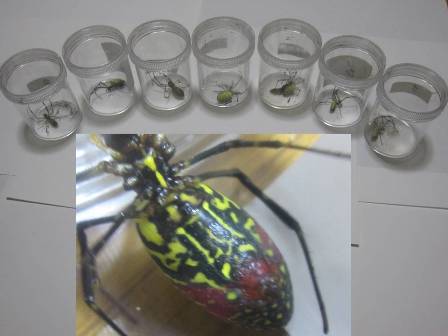Prof. Dr. Bin Mori:
“This is the first discovery in the world that an insect highly concentrates silver. Also, it is evident that bio-concentration of radioactivity in the forest has already started.”
Now guess what will happen if human beings eat radioactive Japanese food?
Still believe the government?
– NHK Calls 20 Millisieverts/Year ‘Low-Level Radiation’ & The Lies Of Minister Goshi Hosono
Think again:
– Silent Death – Horror Scenario Awaits Japan (The Low-Level Radiation Myth Exposed)
– #Radiation in Japan: Spiders in Iitate-mura Concentrating Radioactive Silver 1,000 Times (EX-SKF, Nov. 7, 2011):
Dr. Bin Mori is a professor emeritus at University of Tokyo, Faculty of Agriculture. Since the beginning of the Fukushima nuclear crisis on March 11, the professor has been writing his blog focusing on the effect of radiation in plants and remediation of agricultural land.
I have featured his autoradiographs of dandelion and horsetail on my blog before.
In his post on October 30, Professor Mori wrote about his discovery, probably the world first, he made in spiders (Nephila clavata) he caught in Iitate-mura, Fukushima Prefecture, where the villagers were forced to evacuate after being designated as “planned evacuation zone”. The spiders, he found, had radioactive silver (Ag-110m) at 1,000 times the concentration in the environment.
The following is my translation of Dr. Mori’s October 30 blog post, with his express permission:
????????????????????????????????????????????????(Nephila clavata)??????????
Since it was difficult to collect plants in the rain in Iitate-mura, I caught instead “nephila clavatas” in the bamboo groves and cedar forest.
???????????????????????????????????????????????????????????????????????????????????
I don’t know whether the spiders eat dirt itself, but I thought they may have concentrated radioactive cesium in their bodies as they were at the top of the food chain in the forest, eating butterflies, horseflies, and drone beetles that they caught in their webs.
(Picture 1: Nephila Clavata)
?? ?????????????????????????? (Cs-137?Cs-134) ????????????????Cs-137????????????661.7keV???657.8keV??????????????????? ??????????????
I put 4 nephila cravatas together in the germanium semiconductor detector, and analyzed radioactive cesium (Cs-137 and Cs-134) (Picture 1). Then I noticed an unknown energy peak at 657.8keV, right next to the energy peak of Cs-137 at 661.7keV (Chart 2).
(Chart 2: Ag-110m peak detected next to Cs-137)
????????Ag-110m???????????249.5??????????????????????????????????????????????????(????
When I identified this peak, it turned out to be one of the 4 gamma-ray peaks from Ag-110m (nuclear isomer of silver, half life 249.5 days). The other 3 peaks were also detected (Chart 3).
(Chart 3: 4 peaks of Ag-110m identified)
????????????????????????????????????????Ag-110m??????????????????
So, the conclusion is that nephila clavatas have concentrated a minute amount of radioactive silver (Ag-110m), which is one of the radioactive fallout materials from Fukushima I Nuclear Power Plant.
??????????
Cs-134(2.9Bq/4? )?Cs-137(3.9Bq/4?) = 3656Bq /kg???
????
Ag-110m (2.6Bq/4?)?1397Bq /kg???
????The densities of the radioactive materials in the spiders were:
Radioactive cesium:
Cs-134 (2.9 Bq/4 spiders) + Cs-137 (3.9 Bq/4 spiders) = 3,656 Bq/kg live weightversus
Radioactive silver:
Ag-110m (2.6 Bq/4 spiders) = 1,397 Bq/kg live weight?????????Cs(137+134)?Ag-110m???????2500:1 ?????????????????????????????1000????????????????????????????
In the forest where the spiders were caught, the ratio of radioactive cesium (134+137) to Ag-110m was about 2,500 to 1. Using the above numbers, I calculated that nephila clavatas bio-concentrated the radioactive silver in the soil to about 1,000 times.
????????????????????????????????????????????????????????????????????
This is the first discovery in the world that an insect highly concentrates silver. Also, it is evident that bio-concentration of radioactivity in the forest has already started.
??????????????????????????????????????????????????????
I will present the details of my research on Saturday November 26 at the Japanese Society of Science and Plant Nutrition’s Kanto Branch meeting (Faculty of Horticulture at Chiba University in Matsudo City, Chiba). Please come.
???????????????????????????????????????????????
Appendix: I’d like to thank Keitaro Tanoi of University of Tokyo Graduate School of Agricultural and Life Sciences for the measurement.
????????????????????????????????????????????????????????????????????????????????????????????????????????????
PS: The definition of bio-concentration used here is calculated from the ratio to radioactive cesium. I won’t discuss it in details here, but depending on how bio-concentration of radioactive cesium is defined, the concentration ratio of radioactive silver by nephila clavata may be even higher.
In the very last sentence, Professor Mori is literally saying “higher by a digit”. But I am not exactly sure whether he means literally or figuratively, or whether he means higher by single digit or more. (I’m asking the professor for clarification.)
Professor Mori says he is planning to write up the paper on the subject in English and submit it, but he says that’s secondary. The most important thing, he says, is to disseminate information as wide as possible when it comes to radiation contamination, and he uses his blog to post his own unique discovery like this even before he writes it up as a scientific paper.
(What a difference between him and certain researchers who withhold critical information about radiation contamination in Japan so that their papers get accepted by prestigious foreign papers.)


